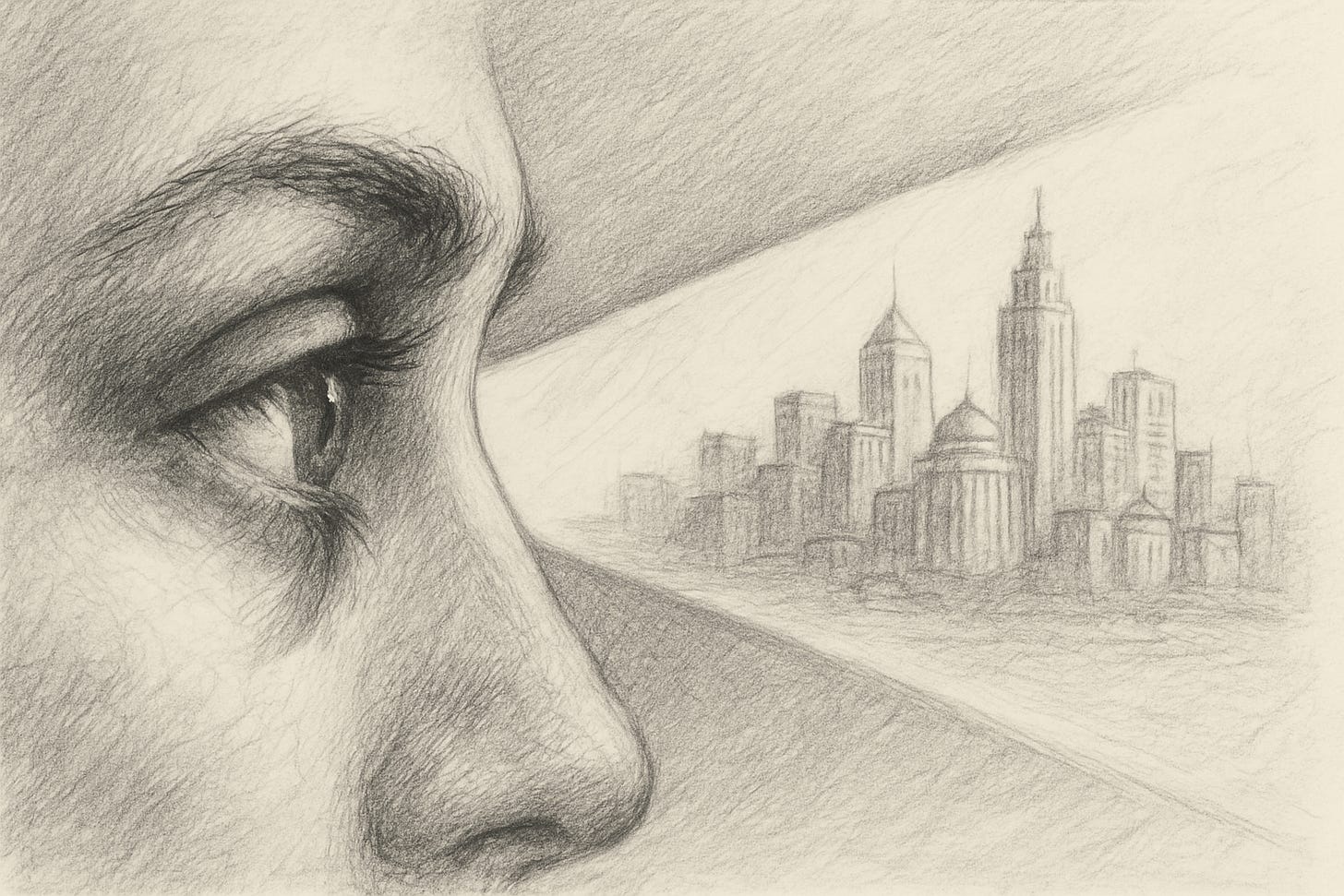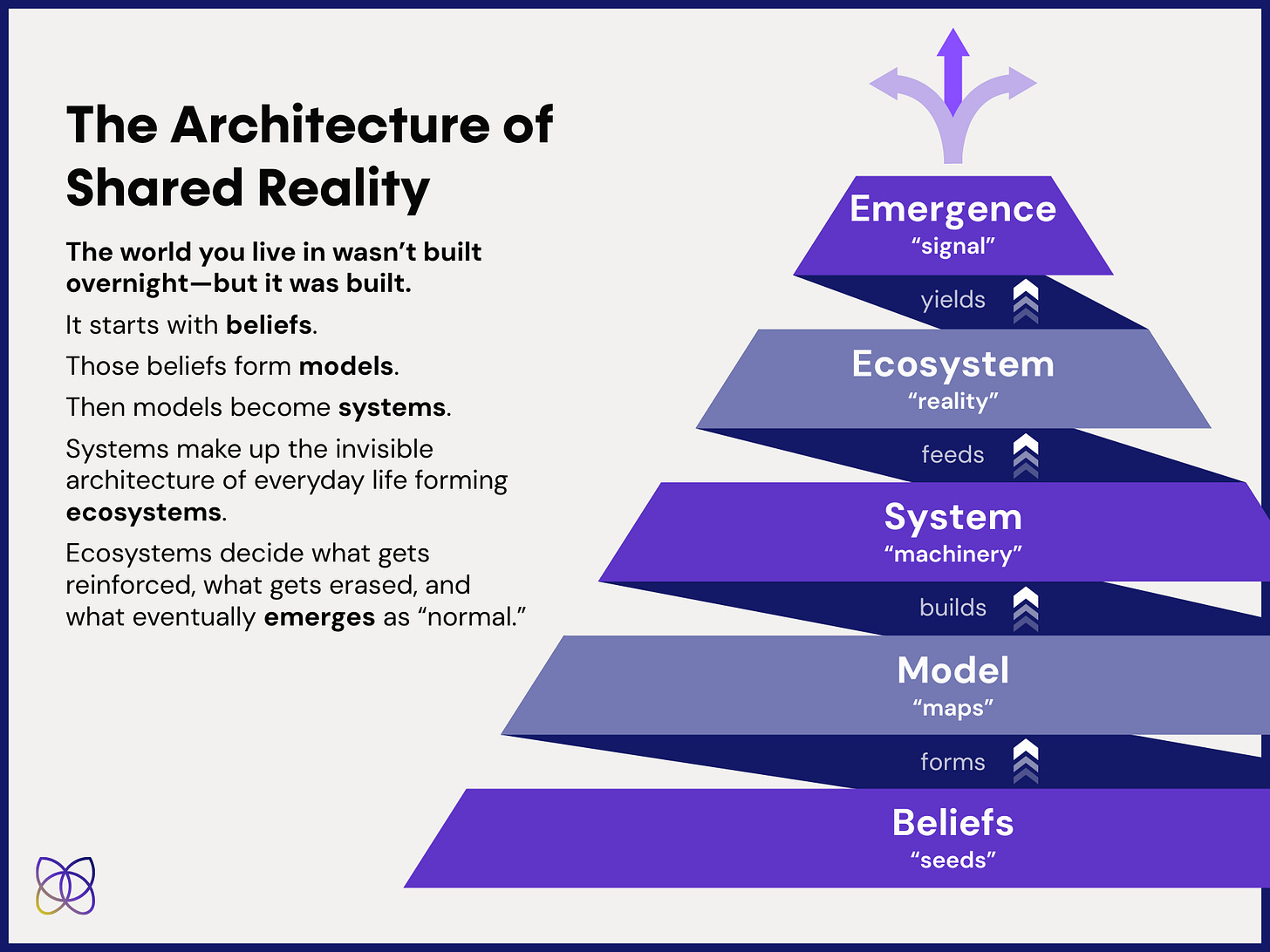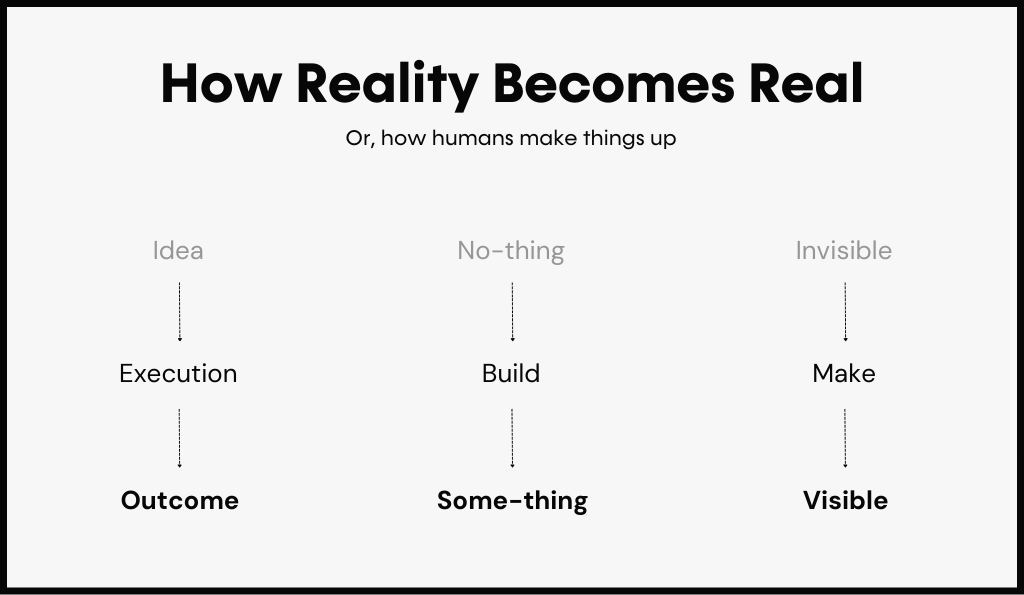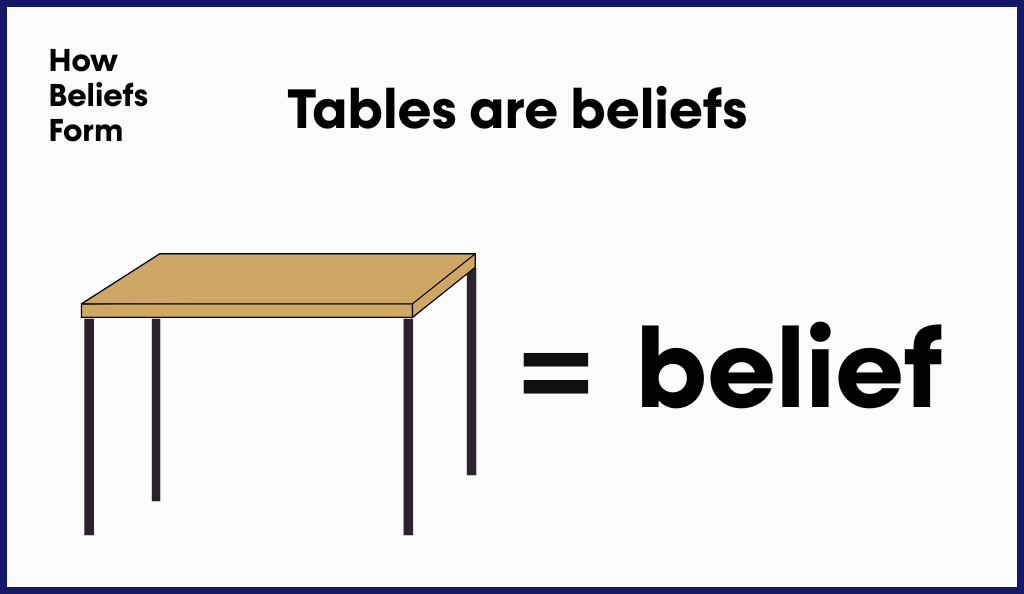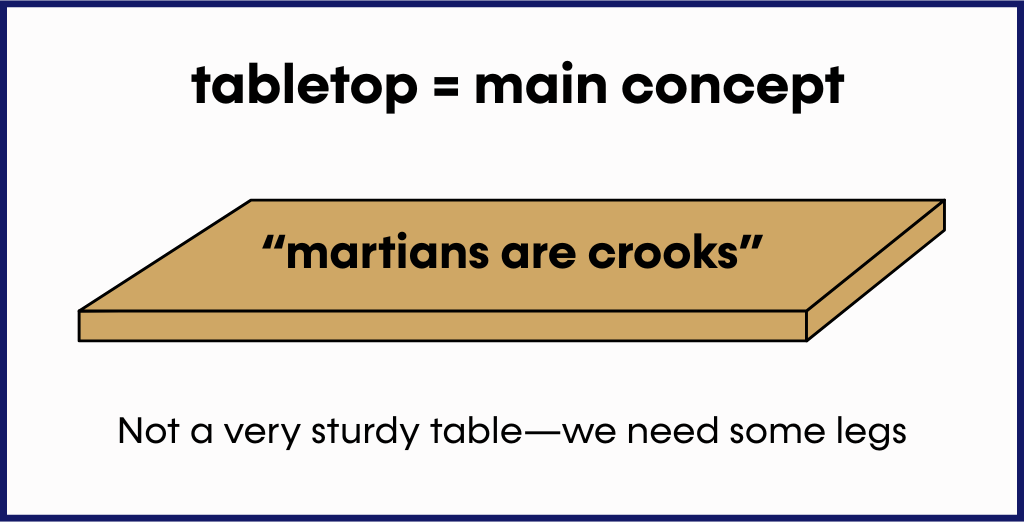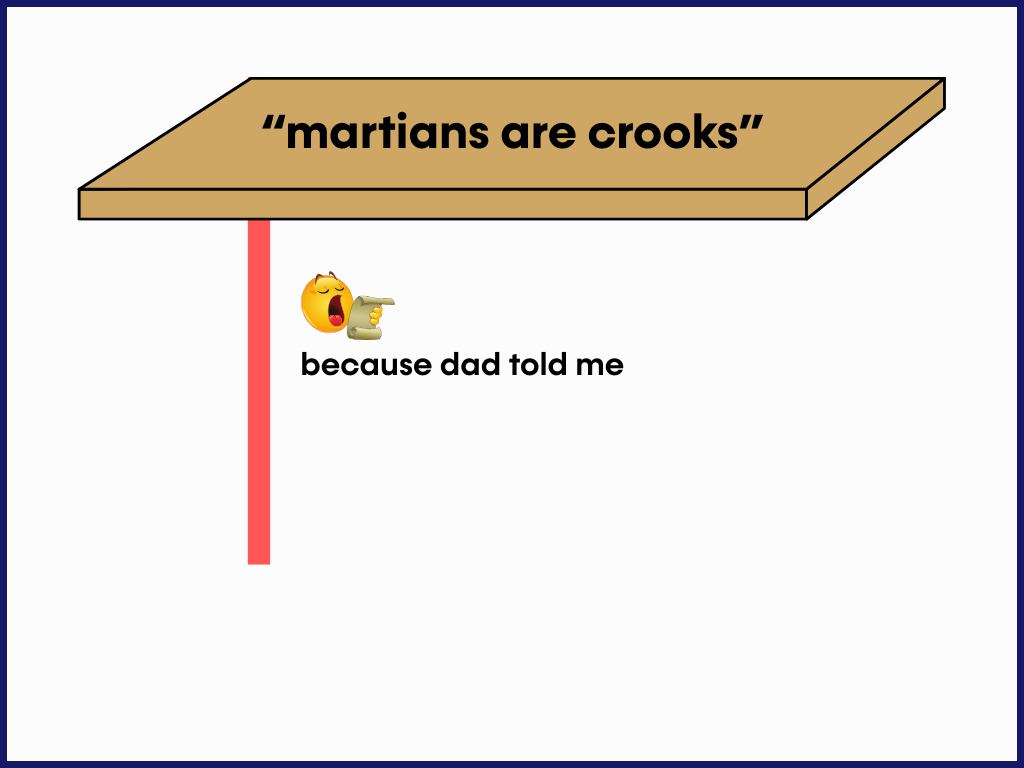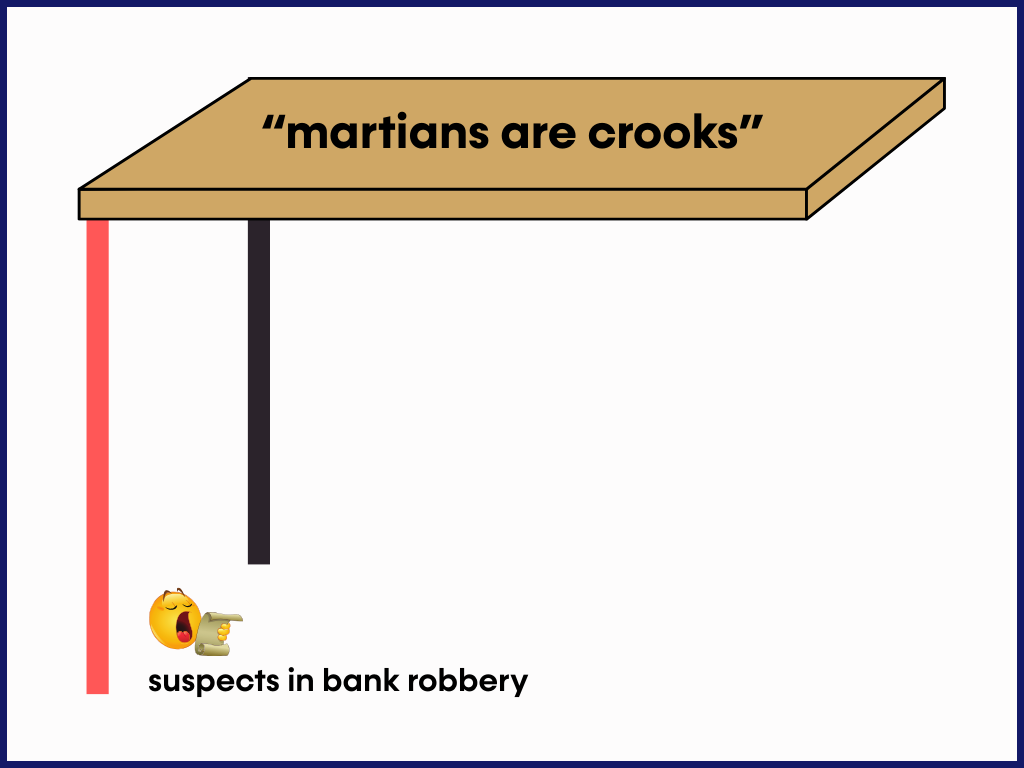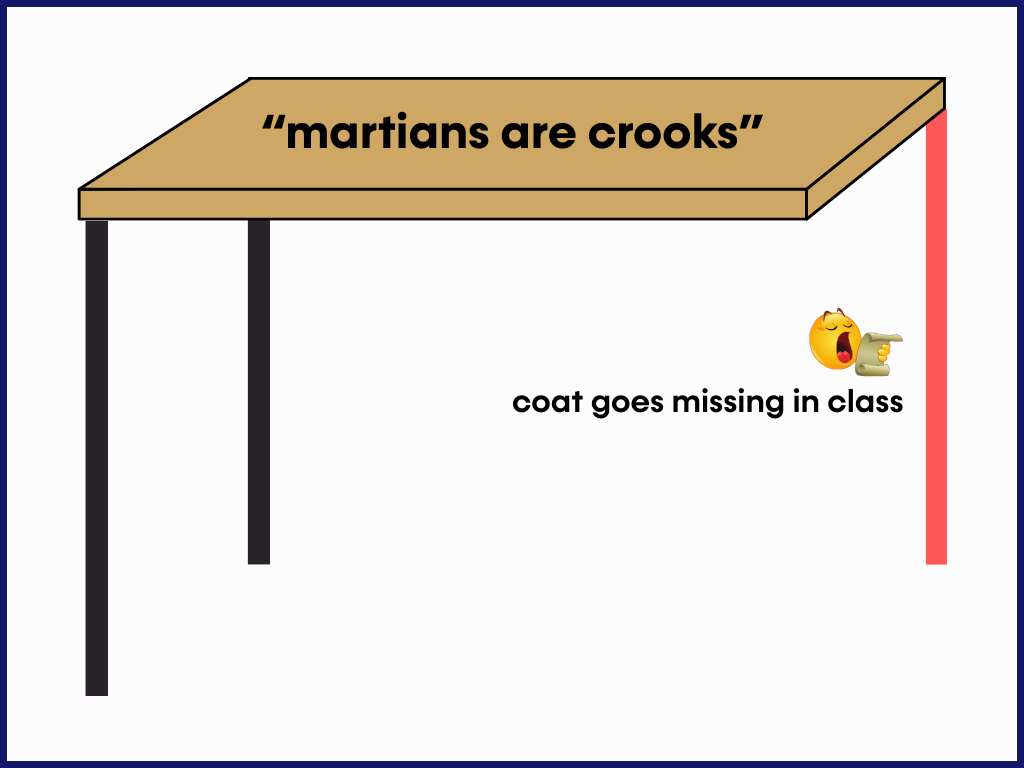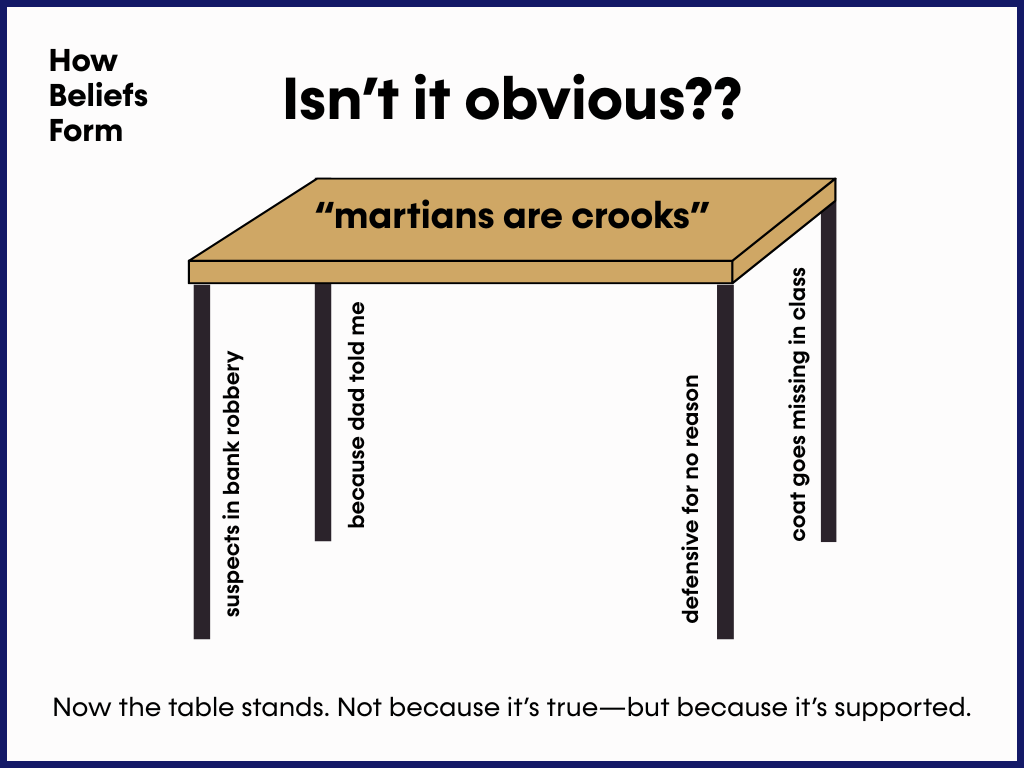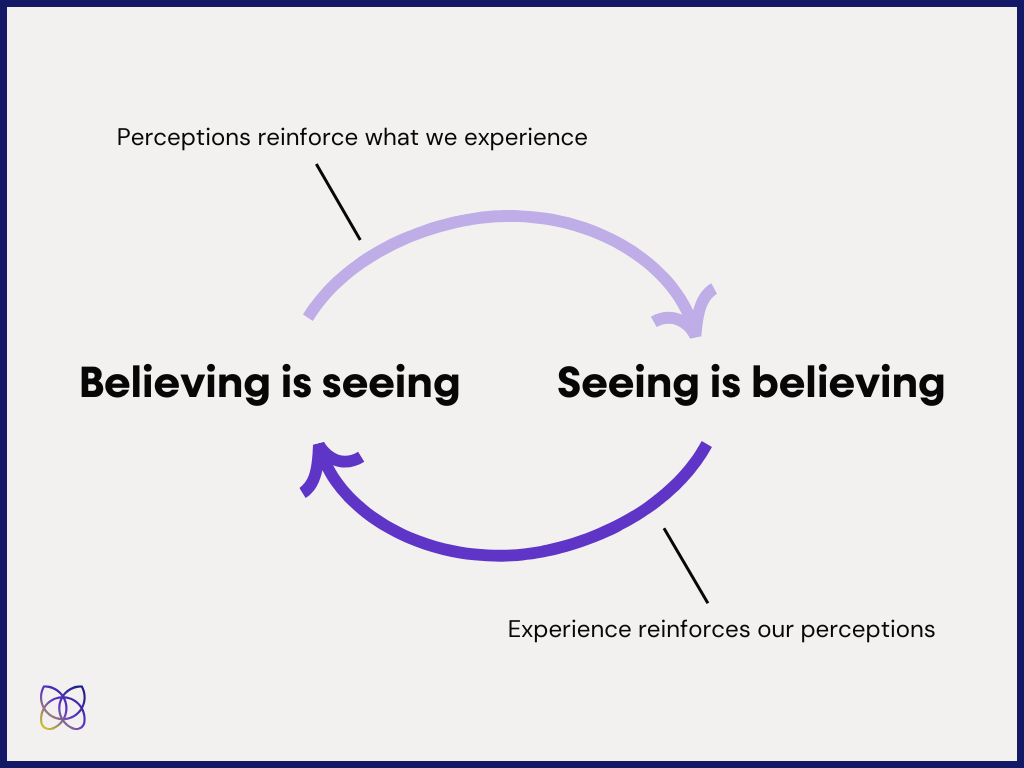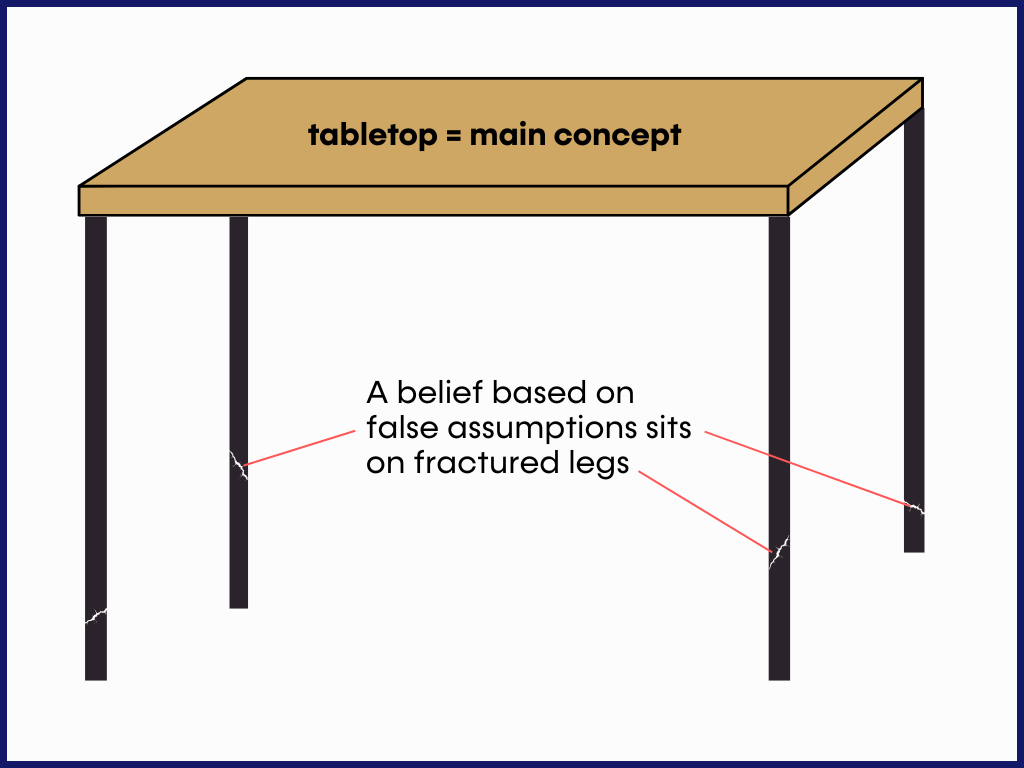1-3: Reality Architecture, Part I
From belief to blueprint—the beginning of what we call reality.
This is part one of a five-part series on how we build reality—and how that shapes which potentials emerge, and which vanish before they begin.
You are here
In the last post, we explored the cost of unrealized potential.
We saw that potential isn’t just a personal loss—it’s ecosystemic. It reshapes communities, cultures, and outcomes across time. It compounds in reverse. And its absence creates a tax we all quietly pay.
But beneath every loss lies a deeper question:
How does this happen—systematically, structurally, and somewhat predictably?
Why does one environment multiply potential while another slowly erodes it?
Why do some ideas flourish while others never surface?
Why do certain people rise, while others remain unseen—no matter how much talent, vision, or care they carry?
The answer is: reality is made up.
Not metaphorically. Mechanically.
We’re surrounded by inherited realities—yet most of us walk through them unaware that any other path exists.
“Everything around you that you call life was made up by people that were no smarter than you. And you can change it, you can influence it… Once you learn that, you'll never be the same again.” ~Steve Jobs
This mini-series on Reality Architecture is about how that happens.
Because if we want to unlock more potential, we have to see how our current reality structure either amplifies potential… or edits it out.
Let’s dig in.
So, a Map and a Territory walk into a bar…
Maybe you’ve heard the phrase: “The map is not the territory.”
It’s a simple idea, but it explains a lot about why we get stuck.
Your internal map of the world—your beliefs, assumptions, cultural norms—is not the same as the world itself. It’s just your best attempt to navigate it.
The territory is what actually exists. The map is how you interpret and move through it.
We all live this every day.
Think of driving a car.
If you grew up in the U.S., your “internal map” includes things like:
—> Driving on the right side of the road
—> Stopping at red lights
—> Turning right on red
But drop that same driver into England? Their map (how they're used to driving) doesn’t match the current rules of the road.
It’s like trying to use a map of Paris when you're in Barcelona.
You’ll get somewhere, just not where you want to go.But here’s the catch: most people don’t realize they’re using a map.
People often mistake their internal version of the world for the world itself.
Or even worse: they assume everyone else is looking at the same map.
(Or that they should.)
That’s how you end up with eight billion people walking through the same territory…while living inside completely different worlds.
And we wonder why there’s so much conflict.
Your reality versus everyone else’s
Right now, as you read this, you're experiencing your reality. You could be doing a thousand other things—but you're here.
You’re interpreting these words through your own lens: past experiences, emotions, expectations, values.
I know you already know this, but it’s worth saying: This is your reality.
Wherever I am, I’m experiencing mine.
And everyone else on the planet? They’re experiencing theirs.
So while we may live in a shared external world—roads, schools, governments—we don’t live in shared realities.
We share the basics, sure.
Green is green, right?
A table is a table. But only up to a point.
Because what happens when green drifts toward blue?
Is it turquoise? Aqua marine? Cyan? Baby blue?
Is it calm or cold? Soft or sterile? Peaceful or corporate?
A table is a table—until it becomes a boardroom table,
Or a kitchen table,
Or a negotiating table.
The moment we zoom into nuance, shared reality begins to fray.
And that’s where meaning gets made—because meaning lives in the margins, in the small differences that decide what we value, what we fear, what we believe is possible.
The world might look the same, but what it means to each of us?
That’s where the architecture begins.
Reality Making 101
Despite our differences, every single person—every culture, every institution—builds its internal model of reality using the same sequence (or process).
It doesn’t matter where you were born, what language you speak, or what generation raised you—your sense of “what’s real” is built through a universal pattern:
Beliefs (or seeds) shape…
Models (or maps), which build…
Systems (or machinery), which coalesce into an…
Ecosystem (reality), which determines what…
Emerges (signal) as visible, viable, or valuable.
Or: Belief —> Model —> System —> Ecosystem —> Emergence
Like this:
We’re going to break each of those stages down—one by one—not just to explain how reality forms, but to show how it filters potential long before it ever sees the light of day.
Because if we don’t understand how reality gets made, we’ll keep mistaking the reality we’ve inherited for the truth.
Let’s start with belief.
Belief: The invisible blueprint
Beliefs are the starting blocks of every reality.
But even beliefs are made up of two invisible forces: a thought and a feeling.
It’s that combination that gives belief its molecular structure, its stickiness, and its staying power.
And that’s where our reality-making machine begins:
With something internal and unseen—a simple belief that eventually becomes infrastructure, policy, behavior, and identity.
From the invisible to the visible. Everything’s made up, like this:
Thought → Model → System → Ecosystem → Emergence
Emotion → Expectation → Norm → Outcome → Reality
Everything you see started as something you couldn’t.
No-thing becomes Some-thing.
That’s the architecture of reality.
Beliefs are tables
Most people think beliefs are just conscious choices we make: “I decide what I believe.”
But that’s not how belief actually works.
Beliefs are rarely chosen, but passed down.
They’re also constructed over time, piece by piece.
A better way to understand belief is to think of it like a table.
Here’s what I mean:
Think of the tabletop to our table as the core idea or concept—
“I’ll never be good at math.”
“Success means making millions.”
But like beliefs, even tabletops can’t stand on their own. A tabletop needs legs to support it. Same thing for beliefs.
The legs are what we’ll call references, experiences, or validations that make the belief feel real. Here’s what those might look like:
Memories: “Remember when that happened?”
Stories: “My friend told me about…”
Observations: “I saw it with my own eyes.”
Authority: “My teacher/parent/boss said so.”
Emotion: “It just feels true.”
The more legs, er, references a belief has, the sturdier it feels, the stronger the belief.
And the sturdier it feels, the less likely we are to question it.
Build-a-Belief
You heard of “Build-A-Bear”? Let’s build a belief.
Let’s start with our tabletop.
First we need a core idea (or our tabletop).
How about: Martians are crooks.
Not really something you’re born thinking.
But let’s watch how it becomes stronger:
Leg 1: My dad says Martians stole from him.
It’s my dad—he’s never wrong. Plus, he wouldn’t lie to me.
A strong, foundational leg forms for our table.
Leg 2: The news reports that a bank was robbed—Martians are suspected.
I knew it! They’re just suspects, but I know the truth. Right dad??
Second leg forms. The table’s not quite sturdy yet, but we’re getting there.
Leg 3: A coat goes missing in class. Half my class are Martians.
It’s gotta be one of them. Sure, I have no proof. But c’mon, man. It’s obvious.
“Isn’t it obvious?” Might be to you, but everyone doesn’t look through the same lens.
Leg 4: I avoid Martians in the hallway. They seem offended.
Why so defensive? Guilty conscience much?
Now my behavior creates the reaction I interpret as confirmation.
And now?
The table stands.
The belief feels solid. Real. Obvious.
Doesn’t mean it’s true, but it does have:
Multiple references supporting it
Reinforcement from trusted sources
Filtered perception that finds confirming evidence
Self-fulfilling feedback loops that seem to validate it
That’s how beliefs get built.
Not through truth—but through accumulation.
Seeing is believing… until it’s not
You've heard the phrase: "Seeing is believing."
But more often, it's the reverse: Believing is seeing.
This loop represents how our brains actually process reality. Every belief becomes a filter through which we experience the world:
What we believe determines what we notice and what we ignore
What we notice reinforces what we already believe
Each experience becomes further evidence, strengthening the original belief
The stronger the belief, the more it shapes what we see
It's a self-reinforcing cycle that creates its own evidence.
Once I believe Martians are thieves, for example:
I start noticing thefts more frequently (selective attention)
I become suspicious of Martian behavior (interpretation bias)
I remember crimes by Martians but forget those by others (memory bias)
I avoid Martians, creating tension I interpret as guilt (self-fulfilling prophecy)
Every incident becomes another leg for my table (belief). The legs stack up, and my certainty grows—not because reality confirms it, but because belief shapes how I process reality.
The more I "see" these patterns, the more convinced I become that
I'm simply observing reality—it never crosses my mind that I’m creating it.
The truth conundrum
Here’s something else to consider: What if none of my legs for my table were true?
My dad’s story? It was his coworker who stole it all along—and he blamed some Martians to cover his ass.
The bank robbery? A follow-up story found that the robbers were just humans wearing Martian masks.
At school? Some girl took the coat. But no one believed the Martian kids when they denied it.
So even though my belief had structure, it didn't have truth.
That’s why beliefs aren’t just private thoughts.
They eventually become public architecture when they’re shared, repeated, and enforced by others. More on this later.
What’s important now is that one person’s belief shapes how they see the world. And how we see shapes how we act, what we attempt, avoid, or never even consider.
But a culture's shared beliefs end up shaping what that world allows.
Whether it’s religion, racism, capitalism, education, or parenting, when two or more people share the same beliefs, they’re essentially constructing the next stage of their reality together.
When these beliefs stabilize at scale, they influence something far more consequential:
What we believe is possible for ourselves and each other.
Before a kid ever tries to lead,
Before an employee ever questions the system,
Before a community ever imagines a different future, beliefs already decide what they expect from themselves.
The belief that someone "lacks potential" festers because beliefs go unexamined.
And as Socrates warned, “An unexamined life is not worth living.”
If that’s true, then not looking deeply into our beliefs is not just wrong—it's a prison that never reveals its own walls.
Beliefs eventually form architecture
That’s why belief is the first—and often most dangerous—stage of reality building.
Because once a belief becomes (s)table, it’s not questioned. And it quickly becomes the lens through which everything else is interpreted.
This sets the foundation for:
The models we accept as normal
The systems we design
The ecosystems we enforce
What we allow to emerge as possible
And reality as we know it
Whether the belief was based on lies, untruths, or incomplete information, it still shapes what happens next.
And when those beliefs become shared, repeated, and embedded in institutions, something bigger happens.
They don’t just shape how one person sees the world.
They start defining what everyone else is allowed to see.
That’s how a single belief, scaled through media, tradition, or policy, can become the quiet engine of a system. One that filters who gets noticed, who gets trusted, or who gets funded.
That’s how potential gets killed long before anyone knows it was even there.
A quick note on truth
You might wonder: But what if my belief is true?
That's fair. I’m not saying truth doesn't matter. But in my experience, especially as it relates to potential, I’m not chasing absolute truth.
I’m seeking functional truth.
I’m ultimately asking:
Does this belief unlock more potential—or not?
That’s a different kind of evaluation, and one I’m asking you to consider.
Some beliefs naturally lead to growth, adaptability, and fulfillment.
Others lead to fear, stagnation, or underperformance.
Take the belief "my intelligence is fixed at birth" versus "my intelligence can grow."
When studied across thousands of cases, people with the first belief consistently avoid challenges and give up faster.
The second belief isn’t more true philosophically—
But it reliably unlocks more of what people can become.
Those patterns aren’t dogma. They’re data.
And by data, I mean observable outcomes:
How people perform under pressure
Whether they pursue challenges or avoid them
If they persist through difficulty or give up
What they ultimately create, build, or become
This is where believing is seeing becomes a critical point.
The belief "I'm not good enough" can be a sturdy table built on countless references, experiences, and reinforcements.
It might even feel unshakably true.
But sturdy doesn’t mean useful.
Prison cells are sturdy, too. They’re well-built, solid, and stable.
But it confines rather than enables.
Some beliefs are like that—structurally sound but functionally limit us.
They may not be “weak tables,” but they constrain and limit potential.
In that sense, the “truths” this framework offers aren’t universal laws.
They’re more like evidential maps—frameworks that have worked across time, context, and relationship to unlock more of what people carry inside them.
I’ll reveal more of these maps as we go.
So, belief is where we begin. It’s the foundational stage in how reality becomes real. Because once enough people share the same beliefs,
They merge into something larger:
It becomes a model.
We go from private furniture (your ‘belief’ table) to public architecture (this is how tables are made).
Models, or shared maps, become:
A framework for interpreting reality,
A shortcut for decision-making,
A quiet agreement about how things work.
And as we’ll see in the next post, these maps don’t just guide us—
They constrain us. Often without our awareness or consent.
Before a single dream is pursued or abandoned,
Before any potential is nurtured or suppressed,
It must first pass through the filter of what we collectively agree is possible.
That’s next.
Coming up: Reality Architecture, Part II: Models and our maps of reality





